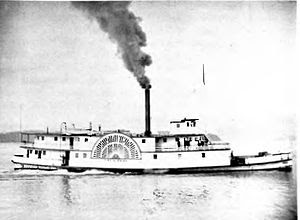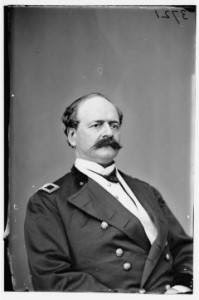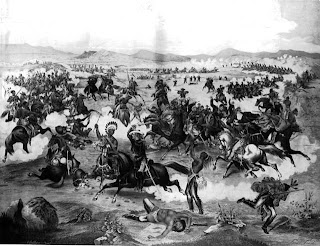Many boats manufactured during this period were sidewheelers, paddle wheels on both sides of the boat. In fact, the sidewheelers were some of the first powered ocean vessels before the screw propeller mechanism was used.
The sidewheeler "Idaho" is pictured to the left. The other type built were sternwheelers with one paddle wheel at the stern. The picture below right is the steamboat "Far West", a sternwheeler launched in 1870 at Pittsburgh, PA. Prices in the 1870's averaged about $50,000-$60,000 for a new steamboat depending on size.
 One obvious advantage with a sternwheeler was that it could navigate up a narrower river than the sidewheeler. The "Far West" was 190 ft. long with a 33 ft. beam.
One obvious advantage with a sternwheeler was that it could navigate up a narrower river than the sidewheeler. The "Far West" was 190 ft. long with a 33 ft. beam.It's amazing how far inland some of these sternwheelers could navigate and much of that credit belongs to a steamboat Captain by the name of Grant Marsh.
Starting out his career as a steamboat cabin boy, Marsh (pictured below right) had the reputation of being the most skilled captain on the Missouri River and a friend of Mark Twain. He is credited with taking steamboats the furthest up the Yellowstone River, a tributary of the Missouri in Montana. Some said Marsh could navigate a steamboat on dew alone. To give you an idea of the dangers of steam boating on the Missouri River, between 1819 and the very beginning of the 1900's, about 700 different boats plied the river with 300 of them eventually being wrecked.
The Steamboat and the Sioux Expedition to Montana
 Our story begins here where the Department of the Army in 1876 contracted two steamboats, The "Far West" and the "Josephine" as part of the Terry/Custer expedition against the Sioux Indians. The expedition which included Col. George Armstrong Custer and his immediate superior Gen. Alfred H.Terry left Fort Abraham Lincoln located about 4 miles south of Bismark, ND in the middle of May and traveled west over the prairie.
Our story begins here where the Department of the Army in 1876 contracted two steamboats, The "Far West" and the "Josephine" as part of the Terry/Custer expedition against the Sioux Indians. The expedition which included Col. George Armstrong Custer and his immediate superior Gen. Alfred H.Terry left Fort Abraham Lincoln located about 4 miles south of Bismark, ND in the middle of May and traveled west over the prairie.The job of the two steamboats (most Indians referred to them as "fire canoes") were to ferry additional supplies for the expedition up the Missouri to Montana. A supply line is very important for any distant military undertaking and the fact that Fort Abraham Lincoln was directly on the Missouri River which upstream went west/northwest into Montana was an advantage. The river trip was about 700 miles.
After being fully loaded at the fort, the "Far West" departed in early June on it's trip up the Missouri to the mouth of the Powder River. It was there that General Terry (pictured below left) was to meet the boat and establish the supply camp. Upon reaching the Powder, Terry sent scouts ahead up to the Yellowstone River to locate the boat. The steamboat was already moored and upon hearing this Terry rode up to the Yellowstone.
The Expedition Headquarters
The general then decided to make the "Far West" his expedition headquarters. With Captain Grant Marsh at the helm Terry knew he would be able to go further up the Yellowstone as the ground troops moved parallel up the Powder.
Terry used the "Far West" as a staging area to begin the assault on the Sioux village they assumed was somewhere to the south.
He had Captain Marsh navigate up the Yellowstone to a point a few miles east of the mouth of the Rosebud River. Terry then called a meeting on the boat with Custer and other officers on the afternoon of June 21st. Maps were laid out and plans discussed and after a few hours the meeting adjourned. Everyone had their orders and Custer, who had his Dakota column camped on the nearby shore, rode out the next morning June 22nd.
At that point Gen. Terry had the "Far West" move further up the Yellowstone to the mouth of the Little Bighorn River. Captain Grant Marsh was probably the only boatman with the skill to continue that far up the Yellowstone. On the narrow river and everyone aware that Sioux warriors were nearby, the "Far West"as a precaution moored on a sand bar in the middle of the river rather than on shore. The Sioux had a history of attacking boatmen.
After the troops had their orders and left the "Far West" on June 22nd, General Terry had very little information on the status of their march. What ensued was the Battle of the Little Bighorn. Most know that thiswas a disaster for the 7th Cavalry being vastly outnumbered by some 2,000-3,000 warriors.
Custer's immediate command was wiped out to the man and a nearby detachment of three companies suffered many killed. The picture to the left from the Denver Public Library depicts Custer's battle.
Scores of books have been written about the battle itself but what is also interesting is the role the steamboat "Far West" played in the aftermath. The boat was hired at $360/day to ferry the expeditions supplies up the Yellowstone. It was then ordered to become Terry's headquarters for the expedition. It's next duty was something totally unexpected. After confirmation of the disaster was received on June 30th Captain Marsh was ordered to prepare the boat for ambulance duty.
Marsh had grass put onboard covered with blankets to make an area for the wounded. Several days after the battle the wounded were arriving escorted by the Montana column. Fifty wounded soldiers were eventually put onboard and General Terry gave Marsh the order to return to Bismark/Fort Lincoln as quickly as possible.
A Record Was Made
What happened next was probably a speed record at it's time and one of the most remarkable exploits in steam boating.
The 400 ton "Far West" with it's wounded soldiers traveled safely some 750+ miles down the Missouri back to Fort Lincoln in about 54 hours. This can only be credited to Grant Marsh's skill. Once the boat reached Bismark on July 5th the news of the disaster spread rapidly and details were telegraphed east.
Nine days later the "Far West" and Marsh steamed back up the Missouri to the Little Bighorn with supplies and horses for the troops still there. I think we can say that the "Far West" served the army far and beyond the call of duty.
In the years following, the "Far West" continued it's travels on the Missouri until it was wrecked in 1883. Since the average lifespan of a steamboat was only about 5 years (due to the hazards of steamboating) , the "Far West" seemed to be fortunate.
In a twist of irony, in 1883 the "Far West" was called upon to transport Sitting Bull, one of the leaders of the Sioux renegades in 1876, between two military forts after his return from Canadian exile.
Grant Marsh had a sixty year career piloting steamboats and died in Bismark in 1916 at age 83.
Another story I believe you'll find interesting is Custer's involvement years earlier in the Washita River Battle. This battle occurred in 1868 within the Indian Territory and had repercussions all the way to the Battle of the Little Bighorn. Another story we've published about the aftermath the Little Bighorn Battle is the significant army victory at the Battle of Slim Buttes in present day South Dakota. It's a very interesting story.
The sites below offer additional information on the "Far West" and Missouri steamboats.
www.time.com/time/magazine
www.westerncoversociety.com
The sites below are additional trip suggestions and information.
www.fortlincoln.com
www.fortwiki.com/Fort_Buford
www.history.nd.gov/historicsites/buford
www.1856.com
(Article copyright Western Trips)





